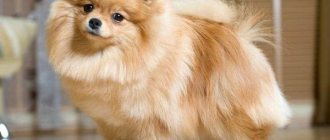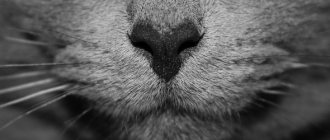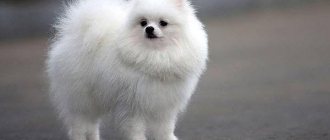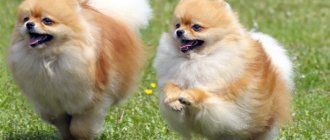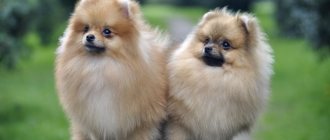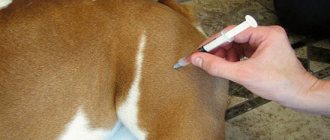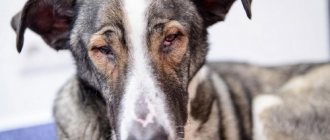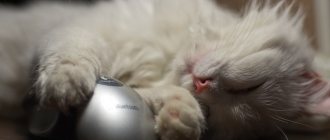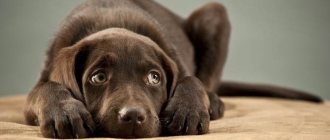Features of hair care
Orange fur is one of the main advantages of the breed. It is long, especially around the neck, where a real “lion’s mane” grows, airy, with a very thick undercoat, easily tangled and matted. Spitz have an arctic type of coat (protects from heat in summer and from cold in winter), so complete removal of hair spoils its structure, the hairs grow thin, weak, and fall off faster. The basic principles for caring for the skin are regularity and plenty of time. Then your Pomeranian will always look healthy and well-groomed.
Pomeranian Spitz: care and maintenance
Keeping this animal in an apartment or house will not cause any trouble, since it requires minimal care. Of course, the main pride of this breed is its thick coat with undercoat. Therefore, they need to be brushed regularly, paying special attention to the area behind the ears and on the hips.
Photo from groomingdogs.ru
All puppies look like miniature foxes and bears when they are babies, but they change as they age. You can restore their spectacular appearance with a haircut. The peculiarity of grooming a Pomeranian is that only the top layer of hair is cut so that it is the same in length as the undercoat. After shortening, the groomer shapes the haircut, paying attention to the paws and head.
You need to know this!
It is strictly forbidden to cut off the inner layer! Shaving and clipper haircuts are not permitted. The undercoat of this breed does not regenerate.
It is recommended to bathe Pomeranians as rarely as possible: during molting, before an exhibition, if the pet is very dirty. It is better to purchase a special shampoo for this that is suitable specifically for this breed, since their skin is prone to dandruff when it dries out. Before water procedures, the dog must be thoroughly combed.
Photo from the site provsehsobak.ru
One of the weak points of these dwarf dogs is their teeth. But if you regularly clean them with a special brush, no problems or illnesses will arise. You should wipe your pet's ears and eyes as needed. This can be done with a regular cotton swab, after moistening it with boiled water.
The small size of Pomeranians makes it possible to teach them to go to the toilet both outside and inside the house (in a tray with litter or in a diaper). When choosing a leash for walking, be sure to pay attention to the tape measures. These dogs are very inquisitive. Sometimes they are cunning and pretend not to hear their owners in order to reach where they need to go. A tape leash will make it easy to keep them at a distance from danger.
Basic procedures
Grooming consists of combing, washing and cutting; Each procedure has its own frequency and characteristics. After each manipulation of the fur, reward the dog with a treat, especially if it behaved well.
Photo: wikimedia.org
Combing
Regularity: once a week - for a short-haired dog, twice a week - if the Spitz is uncut. Rain while walking is a reason for extra brushing.
Means: combs with teeth of different frequencies, massage brushes - do not damage the hair and do not cause pain to the dog; conditioner and spray - make combing easier and improve appearance. Select the frequency of the teeth so that it does not allow tangles to pass through, but also does not pull out hairs. Do not use powder brushes: they injure the skin and cause inflammation.
Procedure: carried out at home, on a table, the dog should lie on its side; For the first time, you can brush the puppy on your lap. Mats often form in the groin, under the jaw, near the front legs and behind the ears. Pay attention to these places first. You need to brush in the direction from the tail to the head, against the growth of the hair - this way the skin is better aerated (especially important for wet wool). At the end, fluff the fur with your fingers - this way it will remain fluffy and stuffed longer. If your dog has problem hair, you have neglected it, cut the mats yourself. If you will be participating in an exhibition in the near future, it is better to contact a professional groomer: perhaps he will be able to untangle the tangles with the help of anti-tangle products.
If you have aggression when scratching, watch this video.
Bathing
Regularity: once every 1-2 months and outside the schedule before the exhibition.
Products: Use dog cosmetics for washing. Human (even expensive and well-known) shampoos are not suitable for this purpose.
How to choose dog cosmetics:
- one brand for shampoo, antistatic agent and conditioner,
- hypoallergenic,
- special bleaches - to whiten the areas under the eyes of white Spitz dogs,
- powdered, dry shampoos for animals that do not like to bathe.
Procedure: carefully plug the dog's ears with cotton swabs to prevent water from getting into them, dilute the shampoo and conditioner separately with water, wet the skin well with warm water, distribute the shampoo, lather, rinse. Treat the washed fur with conditioner and rinse. Wash your Pomeranian only after brushing.
Drying
Regularity: Be sure to dry the fur after each bath. Deep in the orange skin, which remains wet for a long time, an environment favorable for bacteria and fungi is created.
Remedies: do not just leave your dog to dry, be sure to use a hairdryer, which you will have to gradually accustom the animal to.
Procedure: First thoroughly dry (but do not rub!) the dog with a large towel, then dry with a hairdryer, lifting the hairs with a comb and directing warm air to their base. Dry wool needs moisturizing: apply a moisturizer to the under-dried coat and let it dry.
A haircut
Regularity: haircut is necessary occasionally: as needed to remove tangles, and before the exhibition. In any other case, it is not necessary to trim the Pomeranian's coat.
Procedure: the fur is trimmed, overgrown (usually by 1.5-2 years) pieces on the sides are removed, the ears are shaped, outside and inside. Trimmed fur looks more well-groomed.
You can cut your hair for the first time when your Pomeranian is 3 months old. Most often, Pomeranian owners choose the Mouton haircut. Never shave your Pomeranian head!
Bathing
An important point in caring for a Spitz is bathing it. Under normal conditions, they are washed when the animal is very dirty. Bathing, as well as combing, should not be overused. Otherwise, the quality of the coat can deteriorate, which will negatively affect the dog’s appearance.
How often can you wash your Spitz? This breed of decorative dogs can be bathed once every 1.5 months. But if there is an urgent need, this procedure is performed more often. Naturally, because of his restlessness, a puppy will have to be bathed more often than an adult.
It is important to know how to bathe your pet. In order for the coat to look healthy and beautiful, it is necessary to use special shampoos. You only need to wash your Spitz with them, otherwise his coat may lose its softness and fluffiness. In stores you can find dry shampoos sold in aerosol form.
How to wash in this case is written in the instructions for using dry shampoo. They are applied to the fur, after which the animal is combed. The substance binds particles of dirt and grease, neutralizing them. Such means are often used before exhibitions, when it is not possible to spend a lot of time on bringing the dog into a clean appearance.
Bathing is performed as follows:
- first the animal is walked;
- The dog is not fed before bathing;
- First, the dog should be combed well. To prevent the wool from splitting, it is sprayed with water from a spray bottle;
- You need to carefully cover your pet's ears with cotton wool. Cotton swabs will prevent moisture from penetrating inside the ears;
- Now you can bathe. First, you should wet the entire coat with water, and then apply shampoo to it. In the end it just washes off.
It is worth noting that this breed loves to swim. Therefore, there should be no difficulties in carrying out this procedure. To bathe representatives of this breed, you should use specialized shampoos for long-haired dogs, balms or conditioners with an antistatic agent.
Similar article: How to train and raise a Spitz yourself
The best choice would be a hypoallergenic shampoo. If the animal has a snow-white color, then professional bleaching products are needed - liquid shampoos and dry powders. These products will add shine, cleanliness to the coat, and also protect the dog’s skin from pathogenic microflora and UV rays.
When Spitz dogs shed, they cannot be washed.
The fact is that at this time the wool rolls up very much, forming tangles. Therefore, bathing will provoke increased shedding. After this, it is difficult to comb your pet, as you can injure its delicate skin. Therefore, if your Spitz gets dirty during shedding, you can clean only the contaminated areas using the same dry shampoo.
We recommend this article:
How to keep and properly care for a Spitz
Does a Spitz shed?
The Pomeranian is a highly shedding breed, mainly due to its very thick undercoat. It is not for those who are allergic to dogs. The first molt occurs at 3.5 - 4 months and then 2 times a year: in autumn and after winter. Bitches also change their coat before estrus and after giving birth. When your dog begins to shed, switch to daily grooming; the procedure is no different from regular combing, only it is performed even more carefully and longer in order to have time to remove all the dying hairs. If you don’t brush your shedding dog for at least one or two days, you risk getting a tightly matted “felt boot” of unshed hair that only needs to be cut.
Shedding stages:
- guard hair falls out (the fur sharply loses volume),
- the undercoat changes (almost imperceptibly).
Combing
In order for your Spitz to shed as painlessly as possible, it needs to be brushed. You can start brushing your puppy at 3-4 weeks. This procedure is performed with a special soft brush. The animal must be placed on your lap or placed on a special table. Then the comb should be carefully run along the fur against its growth. Particular attention should be paid to the armpits, ears and groin.
The softest wool grows here. If a puppy or an adult dog has tangles, they must be carefully plucked out. Combing should be done 1-2 times a week. During the shedding period, the undercoat should be combed every day.
Similar article: Description and main varieties of the large German Spitz
How to help a dog
At the end of the molt, you may not recognize your Spitz: he loses so much hair that he looks like a “naked” Chihuahua. Do not be surprised. A young orange grows again by eight months, and until the age of three its skin only becomes longer and more luxuriant. After three, the shedding is no longer so noticeable.
The very first, junior molt has its own characteristics, as puppy fluff is replaced by mature hair:
- often changes the dog's color to a more even, monochromatic one,
- the appearance of young dogs changes more noticeably than adults,
- first the muzzle and paws go bald, then everything else.
If your pet has suddenly lost both guard hair and undercoat, balance its diet in proteins, carbohydrates and fats, and add multivitamins.
Do not bathe your dog while shedding: washing will cause more shedding.
Peculiarities
The life of a dog's hair has four phases:
- height;
- decline in activity, the follicle returns to the resting stage;
- destruction of the bulb;
- dying off.
First the awn falls out, followed by the undercoat. The down of the babies is similar to the stuffing material used for stuffing plush toys; it is thick and dense.
People suffering from allergic diseases are not recommended to have fluffy Pomeranians. This can greatly affect the course of the disease.
Depending on health and temperament, one animal sheds slowly, while another sheds lightning fast.
During heat, the bitch sheds a little guard hair; pregnancy can also cause hair loss. After giving birth, when feeding puppies, the mother gives everything the babies need, thereby weakening her body. Shedding while feeding puppies is common. But you should carefully monitor that it is not pathological. Exhibition dogs require constant attention. The bitch should be fed very well, adding all the necessary vitamins, so that her appearance suffers as little change as possible.
Vitamins for wool
Specialized vitamin and mineral complexes for fur will help restore and continue to maintain your pet’s radiant appearance.
There are products for internal and external use (lotions, fortified oils).
- Farmavit Neo: given for impaired pigmentation, long shedding, peeling and itching, during pre-show preparation.
- Omega Neo+ “Shiny Wool”: immediately contains omega-3 acids, biotin and brewer’s yeast (a source of B vitamins).
- Beaphar Doggy's Biotine: recommended for long-haired breeds, improves the appearance of the coat.
- Russian preparations “Tsamaks”, “Stol”, “Rial”, “Spirulin” will add richness and brightness to the red color.
- Fortified treats Sanal Yeast Calcium, 8in1 Brewers Yeast, 8in1 Nutricoat: promote the growth and strengthening of fur, “raise” the undercoat.
- Veda Phytomins: functional food, recommended for dogs prone to pathological baldness (fungi, parasites, allergies, etc.).
A haircut
Due to the fact that this breed is distinguished by its fluffiness, the animals are often shorn, giving their bodies different shapes. The Pomeranian Spitz most often undergoes this procedure. However, molting serves as an additional reason to trim a representative of another species. The haircut can be very diverse: teddy bear style, along the edge, etc. Thanks to the haircut, even a shedding pet can look beautiful.
Now you know what to do when your Spitz sheds. During this period, the main thing is to carry out all grooming procedures in order to keep the “coat” in perfect condition. Remember that you need to take good care of your pet.
Similar article: How to keep and properly care for a Spitz
When to go to the vet
- if hair falls out in places, in clumps (outside of molting periods),
- if it does not grow for a long time (alopecia),
- if the skin is flaky, itchy, inflamed,
But it’s not about cosmetics or nutrition.
The reason may be:
- allergies (antihistamines, exclusion of allergens (often flea medications)),
- external parasites (topical and injectable preparations for fleas and ticks, including scabies pathogens),
- fungi - trichophytosis, microsporia (shampoos Dermazol, Nizoral),
- bacteria (antibiotics).
- endocrine disorders - seborrhea (antiseborrheic drugs).
Photo: maxpixel.net
Pomeranian Spitz nursery
The Spitz's coat needs care. Look at the pictures - this is the same dog - before and after grooming. Groomer - Lyubov Sheveleva.
A well-groomed Spitz is, first of all, clean, combed wool, trimmed claws, paws and ears. You need to comb the coat as often as possible. I do this at least once every 2-3 days. You can't comb the coat when it's dry. Before combing, be sure to moisturize it with any conditioning agent, preferably one that makes combing easier and increases volume. As an option - Gliss kur extreme volume. Just soft water (rain) will also work well.
To comb wool you need to have three types of combs.
1. Comb. The best thing I've ever held in my hands is Chris Christensen 004.
2. Brush. Either Chris Christense or MaxiPin with 27mm teeth.
Spitz combs
3. Puffers. There must be no droplets on the teeth. For paws, the simplest one is enough.
For wool – you can use this (mainly used during puppyhood and during heavy shedding)
The combing procedure is as follows: Spray with conditioner, then carefully comb the fur with a comb from the very base. Then use a slicker brush to comb the paws against the growth of the fur to make them fluffier. And we fluff up the finish with a massage. Here is a diagram of the final combing direction:
Brushing a Spitz
Nail trimming:
Nails should be trimmed at least once every two weeks. Cut down to the blood vessel. If the dog is a show dog, they are cut shorter. If the vessel is damaged and blood begins to flow, you need to quickly use a hemostatic agent - ordinary dry potassium permanganate is what you have at hand. Place it on a cotton swab and burn the claw at the bleeding site. After the bleeding stops, you need to wash off the potassium permanganate so that the dog does not lick it itself. There are ready-made hemostatic agents. I use Bio-Groom Sure Clot - Bio-Groom hemostatic powder. Very convenient and does not need to be washed off. Now about how to cut your hair:
Small scissors are suitable - such as in the picture:
Trimming Spitz paws:
To cut the paws, you will need straight scissors - directly for the haircut itself, and thinning scissors - to give the final shape and volume. I use regular hairdressers. You need to carefully trim the fur between the paw pads and cut off any hair sticking out from the top of the claws. The picture shows the foot on the left before cutting, and on the right after. Although I would shorten the one on the right further.
Here is a neatly trimmed Spitz paw:
We trim paws, ears, claws
Ear trim:
A Spitz's ears should have a rounded shape. To do this, they are also trimmed once a week. Using your index finger and thumb, we feel the edge of the skin of the ear, pinch and trim all the hair down to it.
Here are the properly trimmed ears:
Spitz coat trimming:
The first thing a Spitz owner should understand is that he is no hotter in such a wonderful coat than you are without it on a hot summer day. Heat exchange in dogs does not occur through the skin, as it does in us. The most effective method of heat exchange in a dog is the evaporation of moisture. This is exactly the process we see when a dog sticks out its tongue and pant on a hot day. The Spitz's coat has two types of hair - fluff and awn. It is their combination that creates a cushion around the skin that prevents the skin from freezing in winter and overheating in summer. By cutting your Spitz's coat short, you deprive him of this protection. Second. When the hair is cut short, the hair stops growing properly. The fluff does not allow the awns to break through, falls off and the dog goes bald. Do you like the fashionable “booty” haircut? Cute, isn't it? Now look - what you have to pay for such a fashion... The picture shows the unkempt fur of a dog that was once cut short...
A very short haircut can cause baldness - a disease called BSD. Do you want to get a dog like this? The question is brewing: where can a Spitz be cut correctly? Under no circumstances in grooming salons!!!! A Spitz should be cut exclusively by a master breeder who knows the characteristics of the coat, does not cut it short, does not use a furminator or clipper, and cuts only with scissors. Look for just such people or learn on your own. Here is a beautifully and correctly trimmed dog:
Washing the Spitz:
You should wash your Spitz no more than once every two to three weeks. The water should be slightly warm. Too hot water provokes shedding. Before washing your Spitz, you need to comb it thoroughly with a comb. For washing we use two products - shampoo and conditioner. When choosing a product, be sure to take into account that it should be for dogs with long hair with a thick undercoat and preferably increasing volume. As an option - series Iv San Bernard. Banana shampoo and conditioner. I buy here.
Wash with shampoo twice, rinse thoroughly and apply conditioner for a few minutes. Thoroughly rinse off the conditioner, give the dog a shake and wrap it in a towel for a few minutes. Then we comb the dog with a comb, moisturize it with Gliss kur conditioner and start drying it with a hairdryer, fluffing the fur with a slicker or brush. The coat must be completely dry. If your dog has dry, brittle, coarse fur, you can use hair masks. In the Iv San Bernard line, for example, this is a restorative mask with grapefruit. Among more expensive washing products, I can recommend Chris Christensen, Isleofdogs, STARFIRE'S cosmetics.
Remember, the wealth of a Spitz is its coat. And it requires good care - then it will delight you with beauty and health.
Owner reviews
Violetta: “I never wanted to cut my dog’s hair short, because, in my opinion, such hair is unpleasant to the touch. We once had our ponytail cut short, and at the slightest tactile contact it was noticeable that the smoothness that, say, was on the back had disappeared.”
Sasha: “The most amazing thing is that after combing a huge mountain of fur, my dog only becomes fluffier. And even easier. The groomer said that you shouldn't put a harness on a Pomeranian because it creates more tangles in the armpits. But I think it’s better to have tangles than to torment my baby with a collar or a noose.”
How to feed a Spitz
Photo from the site santa-maria-de-guia-de-gran-canaria.clasies.com
You can feed oranges with natural, home-cooked food, or super-premium dry food. Feeding “from the table” is unacceptable! This can cause the animal to:
- inflammation of the pancreas;
- stomach problems;
- bad breath;
- fatty liver.
The finished feeds are perfectly balanced. They contain all the vitamins and minerals a dog needs at different stages of development. But having chosen one food, never suddenly change it to another. This will lead to an upset stomach, which can lead to many diseases. Need to change food? Do it gradually.
Photo from dressirovka-sobak.com
If you want to feed your pet only natural food, remember that half of its diet should consist of meat products. The menu should be based on chicken and beef.
You can also feed your pet:
- sea fish (once a week);
- porridge (rice, buckwheat, rarely rolled oats);
- vegetables (both dry and boiled);
- eggs.
It is recommended to give 25 g of food per 1 kilogram of animal weight. Puppies are fed 3-4 times a day, adult pets - 2 times.
Since this is a small dog, it is not allowed to be given bones. They can injure the esophagus. But beef or lamb cartilage is even useful, especially for puppies, since such a delicacy develops their jaws and is an additional source of minerals.
Photo from animalwild.net
When using natural food, we must not forget about regularly fortifying the dog. If vitamins are not supplied to the body in sufficient quantities, the functioning of internal organs will be disrupted and the condition of the coat will deteriorate.
Also, when you get a Pomeranian, follow these feeding rules:
- Food should be at room temperature.
- Water should only be given filtered and changed once a day.
Milk and fermented milk products can be given, but very little, and it is important to monitor the stool.
